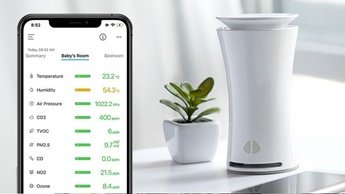Air Quality Readers: How to Read Specifications

Indoor air quality readers are devices designed to monitor the quality of air within any indoor environment. There is an enormous selection of indoor air quality readers available, from units that measure one or two common air pollutants, to readers that capture up to eight parameters.
A vast array of devices and features can make finding the best air quality reader for your needs challenging. To help alleviate part of this problem, Instrument Choice Scientists have constructed a list of important terms and definitions, so you interpret air quality reader specifications with confidence.
Common Air Pollutants
Carbon Dioxide (CO2)
Carbon dioxide is a common chemical compound comprised of two oxygen and one carbon atom. There are many sources of carbon dioxide; it occurs naturally in the Earth's atmosphere and water, and all aerobic organisms produce it including tiny aerobic bacteria, our pets, livestock and humans. High CO2 levels within a home can indicate inadequate air ventilation relative to indoor occupant density and metabolic activity. Indoor CO2 at high levels will cause you to feel drowsy, sluggish, and may trigger headaches.
Particulate Matter
Particulate matter refers to microscopic solid or liquid matter suspended in the air. You will often find particulate matter abbreviated as 'PM' and the particulate matter size as 'PM10' and 'PM2.5.' In addition to concentration, size matters when it comes to the health effects of PM. The most common particulate matter indoor air quality readers measure is PM2.5. High levels of PM2.5 are known to cause cardiovascular and respiratory diseases and cancers. Sources of particulate matter include smoke from fires and wood heaters, car and truck exhaust, and airborne industry pollutants. Air quality reader specifications will often display the PM as a measurable range, for example, PM 0.3um to 10 um.
Volatile Organic Compounds (VOC)
Volatile organic compounds are a variety of chemicals emitted from some solids or liquids in the form of gas. VOC concentration tends to be significantly higher indoors. Examples of VOC emitting products include; paints and lacquers, cleaning supplies, building materials, furnishings, pesticides, and glues. Most home use indoor air quality readers will give you VOC results as the total volatile organic compounds (or TVOC).
Nitrogen Dioxide (NO2)
Nitrogen Dioxide is a chemical compound with the formula NO2. Short term exposure to high levels of Nitrogen Dioxide can act as an irritant to the eyes and nose. Repeated or long term exposure can result in acute or chronic bronchitis. NO2 is the primary source of nitrate aerosols, which form a fraction of PM2.5. Further to this, the presence of Nitrogen Dioxide in the air can contribute to the formation and modification of other air pollutants, e.g. Nitrogen dioxide reacts with sunlight, which leads to the formation of ozone and smog.
Ozone (O3)
Ozone at or near ground level is one of the main components of photochemical smog—ozone forms by a reaction between sunlight and various pollutions such as VOCs and nitrogen oxides. Ozone will reach the highest levels during periods of sunny weather, which can lead to breathing issues, reduced lung function, and asthma attacks. Long term exposure can cause lung disease.
Carbon Monoxide (CO)
Carbon Monoxide is a by-product of incomplete combustion. Common examples within the home include car engines, wood and gas barbeques and fireplaces. If combustion units such as the examples listed are misused, operated in a closed space, or an area with poor ventilation, carbon monoxide can build to dangerous levels. CO is a colourless and odourless gas absorbed by the human body more readily than oxygen, which tragically makes it one of the most acutely toxic indoor contaminants. In acute concentrations, carbon monoxide will quickly deprive the brain of oxygen. Generally-high levels of carbon monoxide can lead to nausea, unconsciousness, even death.
Temperature & Humidity
While temperature and humidity profoundly affect comfort, they also influence the quality of indoor air. When humidity is too low, eyes and skin will become irritated. When humidity is too high mould, and mildew will flourish.
Specifications
Range
The range is the scope of the values the device can measure, given as a minimum and maximum possible value.
Accuracy
Accuracy is the closeness of a measurement to a specific value. Specifications will express the accuracy of a device as a range, i.e., plus or minus a set amount.
Resolution
The resolution refers to the smallest value an air quality reader can display on its screen.
Sample Rate/Time
The sample rate or sample time is the amount of time taken between indoor air quality measurements.
Operating Conditions/Temperature:
For accurate measurements, air quality reader specifications may detail a device's operating temperature range. The operating range will display as a minimum and maximum temperature, sometimes with the addition of a humidity value, expressed as a percentage.
Alarms
Alarms can be audible, visual, or both. It's important to note when checking specifications what type of alarm the air quality reader has (if any) and whether or not they are user-programmable to your individual needs.
Conclusion
Air quality reader specifications can be challenging documents to navigate. Instrument Choice Scientists have assembled this specification guide, so you can expertly browse air quality readers and find the perfect one for your needs.
Browse the full range of air quality readers available at Instrument Choice here.
Want more information on any of the products mentioned above? Speak with an Instrument Choice Scientist! We're here to help! Call 1300 737 871 or email [email protected].
Also interesting
Founded in 1931, Dwyer Instruments has become a global leader in the design and manufacture of innovative controls, sensors, and instrumentation solutions. In this article, we overview a selection of outstanding test instruments made by Dwyer Instruments and stocked by Instrument Choice.

In this week's 'how-to' article, we have assembled a list of the three most common troubleshooting issues you can encounter when using your Lascar data logger with the Easylog USB software. We detail how to troubleshoot the USB connection, battery status, and how you can check that the installation of the USB driver has completed without any hiccups.


